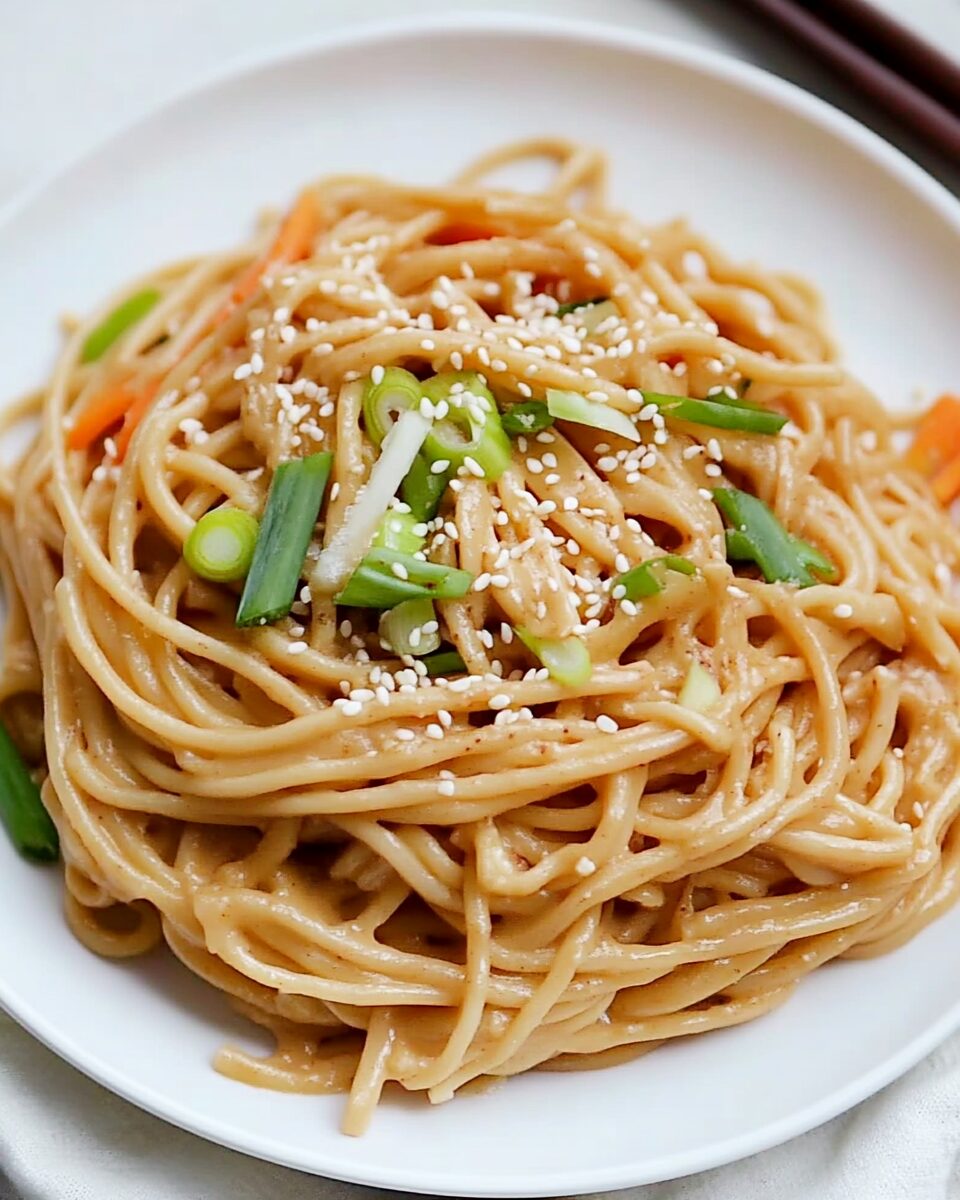These Sesame Noodles with Peanut Sauce offer a delightful harmony of creamy peanut richness and the bright tang of sesame oil and rice vinegar. The smooth sauce perfectly coats tender noodles, making every bite satisfying and flavorful. Toasted sesame seeds and fresh scallions add texture and bursts of freshness, elevating this simple dish to a comforting yet elegant bowl.
Whether served warm or chilled, this noodle bowl is incredibly versatile. It makes a quick lunch or dinner that’s both nourishing and indulgent, with an irresistible blend of Asian-inspired flavors. Adding fresh vegetables like shredded carrots or cucumber can bring crunch and color, turning this into a colorful and healthy meal perfect for any day of the week.
Full recipe:
Ingredients:
-
8 oz spaghetti or Chinese egg noodles
-
1/4 cup creamy peanut butter
-
2 tablespoons soy sauce
-
1 tablespoon toasted sesame oil
-
1 tablespoon rice vinegar
-
1 tablespoon honey or maple syrup
-
2 teaspoons grated fresh ginger
-
2 garlic cloves, minced
-
1/4 to 1/2 cup warm water (to thin sauce)
-
2 scallions, thinly sliced
-
1 tablespoon toasted sesame seeds
-
Optional: red pepper flakes or sriracha for heat
-
Optional: shredded carrots or cucumber for garnish
Directions:
-
Cook noodles according to package instructions until al dente. Drain and rinse under cold water to stop cooking. Set aside.
-
In a medium bowl, whisk together peanut butter, soy sauce, sesame oil, rice vinegar, honey, grated ginger, and garlic until smooth. Gradually whisk in warm water until the sauce reaches your desired consistency.
-
Toss the cooled noodles with the peanut sauce until well coated.
-
Garnish with sliced scallions, toasted sesame seeds, and optional red pepper flakes or sriracha for a spicy kick. Add shredded carrots or cucumber for extra crunch and freshness.
-
Serve immediately or chill for 30 minutes to allow flavors to meld.
Prep Time: 10 minutes | Cooking Time: 10 minutes | Total Time: 20 minutes
Kcal: Approximately 400 kcal per serving | Servings: 4 servings
The Cultural and Culinary Roots
Sesame noodles originate from various regions across East Asia, particularly China and Japan, where sesame oil and peanuts are staples in many dishes. The fusion of sesame and peanut flavors speaks to the region’s use of nuts and seeds to add depth and richness to meals. In China, sesame oil is often used to finish dishes, adding aroma and flavor, while peanut sauces are a common accompaniment to noodles and vegetables in many street foods and home-cooked meals.
Over time, these flavors have been embraced globally, inspiring countless variations. The marriage of these two ingredients with noodles offers a dish that is not only comforting and familiar but also exotic and exciting for many Western palates. It fits well into vegetarian and vegan diets, especially when soy sauce and rice vinegar are used to enhance umami and acidity without the need for animal products.
Why This Recipe Works So Well
The beauty of sesame noodles with peanut sauce lies in the balance of textures and tastes. The chewy yet tender noodles act as the perfect canvas for the creamy, savory peanut sauce, which is brightened by the slight tanginess of rice vinegar and the subtle warmth of ginger and garlic. The toasted sesame oil infuses a smoky depth, making every bite layered and complex without being overwhelming.
The sauce’s creamy consistency ensures the noodles don’t clump together but rather remain glossy and perfectly coated. The use of fresh scallions and toasted sesame seeds adds bursts of crunch and freshness, which prevent the dish from becoming too heavy or monotonous. This interplay of creamy, crunchy, tangy, and nutty elements is what makes this dish so satisfying.
Health Benefits of the Ingredients
While this dish is indulgent in flavor, many of its core ingredients are packed with nutritional benefits. Peanuts, the base of the sauce, are a good source of healthy fats, protein, and essential vitamins like niacin and vitamin E. Sesame oil and seeds bring antioxidants and minerals like calcium, iron, and magnesium, which contribute to bone health and reduce inflammation.
Noodles, especially if you choose whole wheat or alternative grain varieties, can provide sustained energy through complex carbohydrates. The addition of fresh vegetables such as carrots, cucumbers, or scallions boosts the fiber and vitamin content, helping balance the dish nutritionally. Using moderate amounts of soy sauce keeps sodium levels in check, while the ginger and garlic bring anti-inflammatory and immune-boosting properties.
Tips for Making the Perfect Sesame Noodles
To create the ideal sesame noodles with peanut sauce, start by choosing the right type of noodle. Traditional wheat-based Chinese egg noodles or spaghetti work well due to their firm texture, which holds up nicely against the thick sauce. Cooking the noodles to just al dente ensures they retain a slight bite, preventing them from becoming mushy when tossed with the sauce.
When preparing the peanut sauce, whisking the ingredients thoroughly is essential to avoid lumps and create a silky smooth texture. Adjust the sauce thickness by gradually adding warm water—this step lets you customize the coating so that it clings perfectly to the noodles without overwhelming them.
Toast your sesame seeds lightly in a dry pan to bring out their nutty aroma and flavor; this simple step adds a rich finishing touch. Don’t skip the fresh scallions, which contribute a bright, oniony note that contrasts beautifully with the richness of the peanut sauce.
Versatility and Serving Suggestions
One of the greatest strengths of sesame noodles with peanut sauce is how easily it adapts to different occasions and tastes. You can serve it cold or warm depending on the season or preference—chilled for a refreshing summer meal or warm for a cozy dinner.
Adding proteins like grilled chicken, tofu, or shrimp can turn this dish into a complete meal. Including fresh or pickled vegetables such as cucumbers, shredded carrots, bean sprouts, or bell peppers enhances texture and flavor variety. For an extra flavor kick, a drizzle of chili oil or a sprinkle of red pepper flakes can be added to satisfy those who love a bit of spice.
Sesame noodles also make a fantastic side dish for barbecued meats or Asian-inspired mains. They can be prepared in advance and refrigerated, making them a great option for meal prep or packed lunches.
Common Mistakes to Avoid
When making sesame noodles with peanut sauce, a few common pitfalls can detract from the dish’s success. Overcooking noodles is a frequent error that leads to soggy, clumped strands that don’t hold the sauce well. Always rinse the noodles under cold water after cooking to stop the cooking process and help them stay separate.
Another mistake is making the peanut sauce too thick or too thin. A thick sauce can make the noodles heavy and gluey, while a sauce that’s too thin won’t coat the noodles properly. Gradually adding water and tasting the sauce as you go will help you find the perfect balance.
Lastly, neglecting the garnishes can cause the dish to fall flat. Fresh scallions, toasted sesame seeds, and optional veggies bring the necessary crunch and brightness to balance the creamy, rich sauce.
Conclusion
Sesame noodles with peanut sauce is an exceptional dish that combines ease, versatility, and flavor into one satisfying meal. Its creamy, nutty sauce coupled with tender noodles and fresh garnishes creates a delightful harmony of tastes and textures that appeal to a wide range of palates.
Whether you’re looking for a quick weekday dinner, a vibrant lunch option, or a versatile side dish, this recipe is an excellent choice that can be tailored to your preferences and dietary needs. The nutritional benefits packed into the wholesome ingredients make it a nourishing option that doesn’t sacrifice indulgence.
Embracing this dish in your cooking repertoire means enjoying a taste of Asian-inspired comfort food that’s as simple to prepare as it is delicious. With endless possibilities for customization, sesame noodles with peanut sauce will surely become a favorite go-to in your kitchen for years to come.






